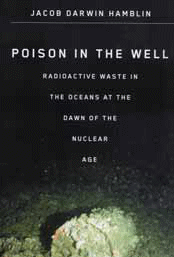SEJournal Online is the digital news magazine of the Society of Environmental Journalists. Learn more about SEJournal Online, including submission, subscription and advertising information.

BookShelf
Poison in the Well: Radioactive Waste in the Oceans at the Dawn of the Nuclear Age
By Jacob Darwin Hamblin
Rutgers University Press, $49.95
Reviewed by VALERIE BROWN
Nuclear power and nuclear weapons advocates routinely stress the scientific foundations of their positions, yet there are so many contradictions and complexities in nuclear policy that rational thought rarely seems to enter the decision-making process. Thus, like all books about anything nuclear, Poison in the Well leaves the reader with a sort of funhouse-mirror disorientation as it documents the twisted logic that policy makers have used — sometimes with assistance from marine scientists — to regulate ocean dumping of nuclear waste from the beginning of the nuclear age to the present.
The book might be of historical interest only if it weren't for the ongoing pumping of large amounts of liquid power-plant-reprocessing waste into the Atlantic, the Irish Sea and elsewhere, and the Mafia's recently-exposed habit of scuttling hot-waste-laden ships near the Italian coast. In a 1972 treaty called the London Convention, nuclear powers agreed to stop dumping packaged, high-level waste into oceans; however, due to porous definitions in the treaty, they can still pump liquid waste into them. These issues make Oregon State University history professor Jacob Darwin Hamblin's tale of the uneasy romance between nuclear delusions and oceanographers' lust for knowledge very timely.
In the early 1950s, ocean disposal seemed more attractive than some of the other ideas under consideration by the Atomic Energy Commission, such as shooting nuclear waste into space or scattering it on enemy territory during the Korean War. Partly out of fears that dumped containers might resurface and cause both embarrassment and risk to civilians, the U.S. decided to end ocean dumping in 1970. Meanwhile the Soviets, while castigating the Western nations for abusing the seas, were tossing submarine reactors into Arctic waters. Hamblin reports that between 1946 and 1993, 14 countries dumped radioactive waste in 80 marine locations. Worldwide, the former Soviet republics and United Kingdom account for almost 90 percent of the material — but the U.S. is responsible for nearly 40 percent of the waste in the Pacific.
Three major forms of ocean-dumped nuclear material emerged: packaged solids like reactor cores and equipment packaged liquids, and sludge and bulk liquids. The first two kinds, it was hoped, would sink to the bottom and only slowly release their radioactivity. The third kind brings us to what I think is the major case of cognitive dissonance with respect to radiation in the ocean: Tons of liquid waste are allowed to pour directly into shallow coastal waters via pipelines out of spent-fuel reprocessing works at Britain's Sellafield complex and France's Cap de la Hague facility.
Early in the nuclear era, little was known about the fate of nuclear waste in the oceans, so policymakers turned to oceanographers for help. The great currents were yet unmapped and the Russians especially hoped to find zones where they could sink waste into deep, still water. Oceanographers led by the renowned Roger Revelle (who also figured out how the oceans might absorb excess atmospheric CO2) worked closely with the U.S. Navy and the Atomic Energy Commission, tapping into research money and data that would otherwise have been unavailable to them. British waste streaming into the Irish and North Seas revealed much to eager scientists about circulation of the North Atlantic and Arctic currents, even as it raised levels of iodine-129 in parts of the Arctic Ocean to more than 4,000 times their pre-nuclear-era levels.
Even today, nobody can say exactly how anthropogenic radiation is affecting marine biota. The field of health physics, nurtured by pro-nuclear interests, has long held that "dilution is the solution to pollution" along with the incorrect notion that there is some threshold level of exposure below which ionizing radiation is harmless. Despite evidence of human cancer clusters near nuclear facilities, the nuclear establishment continues to downplay the risks of exposure to low-level and low-activity radiation. Until better methods of settling the question of its health effects on all life forms have been devised — and these must address epigenetic factors, genomic instability, and non-cancer outcomes — the field's health experts will continue to assert low risk.
Eventually, Hamblin explains, oceanographers parted ways with the nuclear enterprise. Finding deep, still water in the ocean was too elusive. As the environmental movement expanded, ocean scientists became more concerned about the potential health effects of radiation. Oceanographers, Hamblin concludes, had "given up pointing out the importance of the oceans to the future of nuclear energy," emphasizing instead "the uncertain effects of past actions and the continued threats posed by the artifacts of the atomic age lying on the ocean floor."
Valerie Brown, a freelance writer based in Oregon's Willamette Valley, has covered environmental health for 15 years. As a native of southeastern Idaho, she was exposed to nuclear fallout from the Nevada Test Site and has maintained both a professional and personal interest in radiation issues as a result.
** From SEJ's quarterly newsletter SEJournal, Winter 2009-10 issue












 Advertisement
Advertisement 



